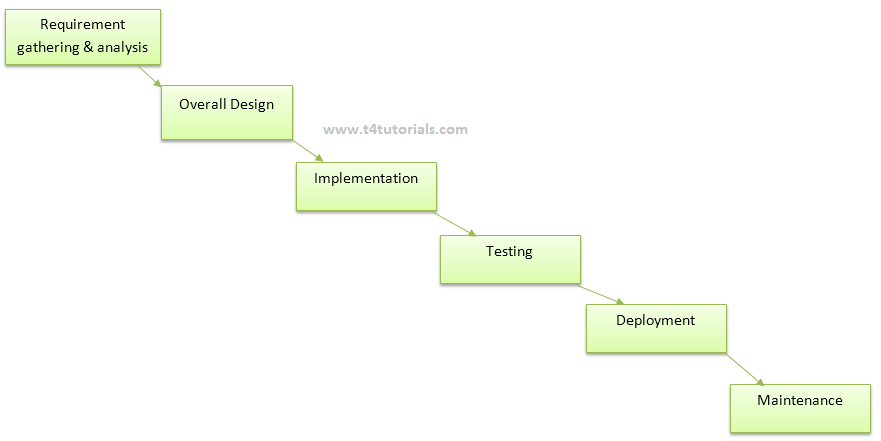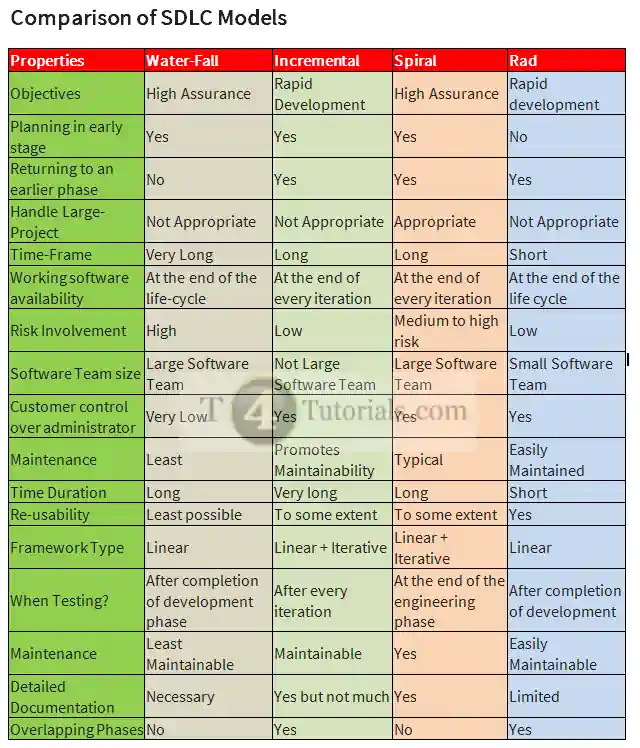Waterfall model, advantages, disadvantages, and examples in software engineering.
What is the Waterfall model?
The waterfall model is a software model that can be adapted to produce the software. The main thing is that if the software team adapts the waterfall model for the production of software than proper detailed planning and proper accurate work is needed in every phase of the waterfall model. This is because while following the waterfall model, the software team is not allowed to move to the previous phase.
What are the phases of the waterfall model?

1. Requirement gathering and analysis
In this phase, all the detailed requirements are gathered from the customer who wants to develop the software. After getting the requirements, the system analyst analyses the requirements that whether the requirement can be fulfilled or not. If customer requirements can be fulfilled then whether these requirements are fulfilled within the budget or out of the budget. After this software team moves to the design phase. Software Requirement Specification (SRS) is managed to gather the requirements.
The feasibility study report is prepared in this phase. The feasibility study goal is to determine whether or not the project is financially and technically feasible(possible to do easily or conveniently).
2. Design
Before starting the design, the software team completely gathered all the detailed requirements from the customer and requirement analysis is also completed. In the design phase, the software team designs the software. Different diagrams are also drawn in this phase for software. Some of these diagrams are class diagram, activity diagram, data flow diagram, state transition diagram, etc.
When a team is completely satisfied with the proposed design, then move to the next phase.
3. Implementation
The system is first developed in small programs called units, which are integrated in the next phase.
Before starting implementation, the software team completely design the system and is now ready to develop the system. Programs are written and all the designs are converted into computer programs, collectively called software.
When the team is completely satisfied with the developed software, then move to the next phase.
4. Testing
Before starting testing, the software team completely developed all the software. Now it’s time to test the software by using different software testing techniques. The most common are white box, black box, and gray box testing techniques.
When the team is completely satisfied with the testing and passes the software for implementation, then move to the next phase.
5. Deployment
Before starting the deployment, the software team completely tested all the software. Now its time to install or deploy the software in its working environment.
6. Maintenance
When software is deployed, there can be many bugs, faults or new modification is needed or not? Maintenance includes debugging and new feature addition.
What are the advantages of the waterfall model?
- Good for small projects
- Easy to use and follow
- When you move to the next phase, you have a clear picture of all previous phases.
What are the disadvantages of the waterfall model?
- Not useful for a large project
- If frequent requirement changes occur then it is a problem to manage.
- There is a big problem if testing fails the software.
- No feedback
- If one of the team members is working on one phase, another team member needs to wait for the previous phase’s completion(no parallelism).
- The maintenance phase required more time.
When to use the waterfall model?
- For small projects
- When requirements are clear
- When customer involvement is less.
- For low-budget projects.
Comparison of waterfall model and incremental model
There are some common difference between waterfall model and incremental model. Some major differences are mentioned below;
| WATERFALL MODEL | INCREMENTAL MODEL |
| Detailed Documentation is Necessary in waterfall model. | Detailed Documentation is done but not too much. |
| Early stage planning is necessary in waterfall model. | Early stage planning is necessary in incremental model. |
| Large team is required in waterfall model. | Large team is not required in incremental model. |
| Overlapping of phases is not possible in waterfall model. | Overlapping of phases is possible in incremental model. |
| Testing is done after completion of all coding phase in waterfall model. | Testing is done after every iteration of phase in incremental model. |
| We have a lot of time to complete the project in waterfall model. | We have a short time to complete the project necessary in incremental model. |
| Flexibility to change is Difficult in waterfall model. | Flexibility to change is Easy in incremental model. |
| Overall Cost of Waterfall model is Low. | Overall Cost of incremental model is also Low. |
| Returning to previous phase is not possible in waterfall model | Returning to previous phase is possible in incremental model. |
| We can’t handle large project in waterfall model. | We can’t handle large project in incremental model. |
| There is only one cycle in waterfall model. | It’s possible to have multiple development cycles in incremental model. |
| Risk is higher in waterfall model. | Risk is lower necessary in incremental model. |
Comparison of Waterfall Model and incremental model
| Properties | Water-Fall | Incremental |
| Objectives | High Assurance | Rapid Development |
| Planning in early stage | Yes | Yes |
| Returning to an earlier phase | No | Yes |
| Handle Large-Project | Not Appropriate | Not Appropriate |
| Time-Frame | Very Long | Long |
| Working software availability | At the end of the life-cycle | At the end of every iteration |
| Risk Involvement | High | Low |
| Software Team size | Large Software Team | Not Large Software Team |
| Customer control over administrator | Very Low | Yes |
| Maintenance | Least | Promotes Maintainability |
| Time Duration | Long | Very long |
| Re-usability | Least possible | To some extent |
| Framework Type | Linear | Linear + Iterative |
| When Testing? | After completion of development phase | After every iteration |
| Maintenance | Least Maintainable | Maintainable |
| Detailed Documentation | Necessary | Yes but not much |
| Overlapping Phases | No | Yes |
Comparison of Waterfall Model and spiral model
| Properties | Water-Fall | Spiral |
| Objectives | High Assurance | High Assurance |
| Planning in early stage | Yes | Yes |
| Returning to an earlier phase | No | Yes |
| Handle Large-Project | Not Appropriate | Appropriate |
| Time-Frame | Very Long | Long |
| Working software availability | At the end of the life-cycle | At the end of every iteration |
| Risk Involvement | High | Medium to high risk |
| Software Team size | Large Software Team | Large Software Team |
| Customer control over administrator | Very Low | Yes |
| Maintenance | Least | Typical |
| Time Duration | Long | Long |
| Re-usability | Least possible | To some extent |
| Framework Type | Linear | Linear + Iterative |
| When Testing? | After completion of development phase | At the end of the engineering phase |
| Maintenance | Least Maintainable | Yes |
| Detailed Documentation | Necessary | Yes |
| Overlapping Phases | No | No |
Comparison of Waterfall Model and RAD
| Properties | Water-Fall | Rad |
| Objectives | High Assurance | Rapid development |
| Planning in early stage | Yes | No |
| Returning to an earlier phase | No | Yes |
| Handle Large-Project | Not Appropriate | Not Appropriate |
| Time-Frame | Very Long | Short |
| Working software availability | At the end of the life-cycle | At the end of the life cycle |
| Risk Involvement | High | Low |
| Software Team size | Large Software Team | Small Software Team |
| Customer control over administrator | Very Low | Yes |
| Maintenance | Least | Easily Maintained |
| Time Duration | Long | Short |
| Re-usability | Least possible | Yes |
| Framework Type | Linear | Linear |
| When Testing? | After completion of development phase | After completion of development |
| Maintenance | Least Maintainable | Easily Maintainable |
| Detailed Documentation | Necessary | Limited |
| Overlapping Phases | No | Yes |
Alternatives to the waterfall model are spiral model, incremental model and agile model etc.





